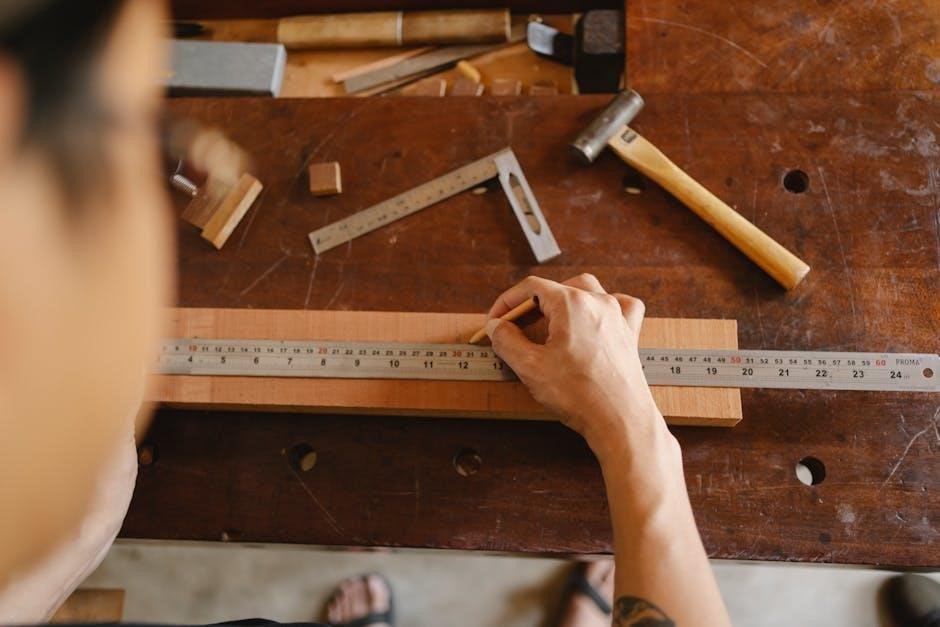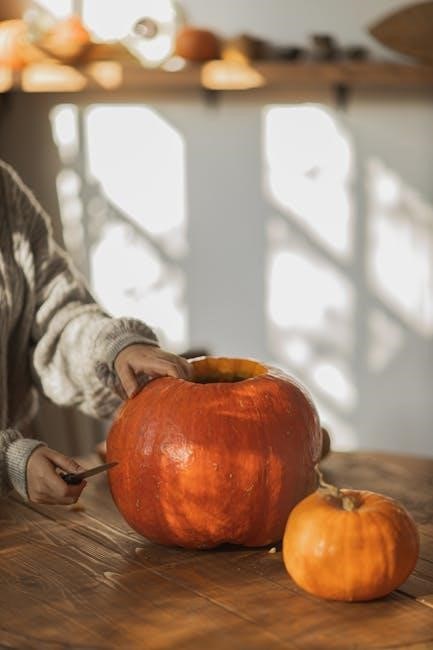A table runner size guide helps you choose the perfect fit for your table, ensuring harmony with your interior design while enhancing functionality and aesthetics.
What is a Table Runner?
A table runner is a decorative fabric strip placed along the center of a table, adding style and protection from spills or scratches. It enhances the aesthetic appeal of a dining space while complementing tablecloths or standing alone. Table runners come in various materials, patterns, and sizes, making them versatile for formal or casual settings. Their primary purpose is to create a cohesive look, protect surfaces, and add warmth to the dining experience. Whether used for everyday meals or special occasions, a table runner is a practical and elegant addition to any table setting.
Importance of Choosing the Right Size
Choosing the right table runner size is crucial for both aesthetics and functionality. A properly sized runner enhances the table’s appearance, ensuring a balanced and polished look. It also protects the table from spills and scratches while allowing space for place settings and decor. A runner that is too small may look out of place, while one that is too large can overwhelm the table. Selecting the correct size ensures harmony with your table’s dimensions, creating a cohesive and inviting dining atmosphere.
Factors Affecting Table Runner Size
Several factors influence the ideal table runner size, including the table’s shape, length, and width. Rectangular tables typically require runners that are two-thirds their length, while round or oval tables need runners that fit snugly without excess fabric. The desired overhang, usually 6-12 inches, also plays a role. Material width and personal decor preferences can further affect size choices. Additionally, the number of seats and intended use, such as formal dining or casual gatherings, help determine the appropriate dimensions for a table runner.

Measuring Your Table for the Perfect Fit
Measure your table’s length and width to determine the ideal runner size, ensuring proper overhang and a balanced fit for a polished appearance.
How to Measure Your Table
To measure your table accurately, start by determining its length and width using a measuring tape. For rectangular tables, measure the longest side for length and the shortest for width. For round or oval tables, measure the diameter or longest dimension. Note the overhang desired, typically 6-12 inches on each end for a standard look. Ensure the runner’s width complements the table, usually one-third of the table’s width. Accurate measurements are key to selecting the perfect runner size for a seamless fit and polished appearance.
Calculating the Ideal Runner Length
To find the ideal runner length, measure your table’s length and add the desired overhang on both ends. For example, if your table is 72 inches long and you want a 12-inch overhang, the runner should be 96 inches long. This ensures the runner drapes elegantly over the table edges. Consider the table shape; rectangular tables require runner lengths that are two-thirds of the table’s length, while round tables need runners that match or slightly exceed the diameter. Always account for the overhang to achieve the perfect fit and aesthetic balance.
Standard Overhang Guidelines
Standard overhang for table runners typically ranges from 6 to 12 inches on both ends, ensuring a balanced and elegant look. For rectangular tables, the overhang should be consistent on both sides, while round or oval tables may allow for slightly more overhang for a dramatic effect. The total runner length is the table length plus twice the desired overhang. This guideline ensures the runner drapes gracefully without overwhelming the table. Proper overhang enhances both functionality and aesthetics, creating a polished appearance for any setting. Always measure carefully to achieve the perfect drape and symmetry.

Table Runner Size Chart
A table runner size chart provides dimensions based on table shape and size. Rectangular runners are typically two-thirds the table length, while round ones match the diameter.
Rectangular Table Runner Sizes
Rectangular table runners typically range in width from 30 cm to 50 cm, with lengths proportional to the table size. For a 2-seater table, runners are 75 cm wide and 110 cm long, while a 4-seater requires 75 cm width and 150 cm length. A 6-seater small table uses a 90 cm wide runner, 180 cm long, and a larger 6-seater may need 90 cm width and 220 cm length. These dimensions ensure a balanced look and functionality, with the runner spanning two-thirds of the table length for a sleek appearance.
Round and Oval Table Runner Sizes
Round and oval table runners typically have a standard width of 50 cm, with lengths tailored to the table’s diameter. For a round table, measure the diameter and add 30-40 cm for overhang. Oval tables follow a similar rule, ensuring the runner extends 15-20 cm beyond the edges. This ensures a graceful drape and balanced appearance, complementing the table’s curves without overwhelming the space. Always consider the table’s shape and size to select a runner that enhances both functionality and aesthetic appeal.
Standard vs; Custom Sizes
Standard table runner sizes are pre-determined, offering convenience and affordability for common table dimensions. Custom sizes provide tailored fits, ideal for unique or irregularly shaped tables. While standard runners suit most needs, custom options ensure perfect proportions, especially for oversized or round tables. Consider the table’s shape, length, and desired overhang when choosing between standard and custom sizes to achieve the desired aesthetic and functionality.

Materials and Their Impact on Size
Materials influence table runner size through weight and drape. Heavier fabrics require shorter overhangs, while lighter materials can extend further, affecting the overall dimensions and fit.
How Fabric Weight Affects Drape
Fabric weight significantly impacts the drape of a table runner. Lighter fabrics, like silk or cotton, drape elegantly and allow for longer overhangs, enhancing visual appeal. Heavier materials, such as velvet or linen, have a stiffer drape, requiring shorter overhangs to prevent sagging. The weight also affects how fabric flows over the table edges, influencing both aesthetics and functionality. Choosing the right fabric weight ensures the runner lies smoothly and maintains its shape, complementing the table’s design without overwhelming it.
Adjusting Sizes for Different Materials
When selecting a table runner, the material plays a crucial role in determining the ideal size. Lighter fabrics, such as silk or cotton, drape elegantly and may require slightly longer lengths to achieve the desired flow. Heavier materials, like velvet or linen, have a stiffer texture and may need shorter lengths to avoid bulkiness. Additionally, the width should be adjusted to complement the fabric’s thickness, ensuring the runner lies flat without overwhelming the table. Always measure and consider the fabric’s natural drape to ensure a balanced, polished appearance.

Styling Tips for Table Runners
Enhance your dining space with stylish table runners that complement your decor. Choose materials and patterns that reflect seasonal themes or personal style for a polished look.
Coordinating with Tablecloths
Coordinating table runners with tablecloths creates a cohesive and elegant dining setup. Choose a runner that complements the tablecloth’s color and pattern, ensuring harmony without overwhelming the space. For a seamless look, opt for a runner narrower than the tablecloth, allowing the cloth to frame it beautifully. Consider matching the runner’s fabric to the tablecloth for a unified appearance or contrasting it for a bold statement. This balance enhances the overall aesthetic, making your table setting both stylish and inviting for any occasion or theme.
Seasonal and Themed Table Runner Sizes
Seasonal and themed table runners offer versatility in size to match various occasions. For holidays, wider runners (40-50 cm) create a festive look, while narrower styles (30-35 cm) suit everyday themes. Wedding runners often extend longer (180-220 cm) for dramatic flair, whereas summer themes may use shorter, vibrant runners (150-180 cm). Themed sizes emphasize visual impact without overwhelming the table. Always measure your table to ensure the runner fits proportionally, maintaining functionality while celebrating the occasion or theme with style and creativity. This flexibility allows you to adapt your table decor to any event or aesthetic preference seamlessly.

Care and Maintenance
Proper care ensures your table runner remains vibrant and well-shaped. Regular washing and ironing maintain its appearance, while storage tips preserve its size and quality over time.
Washing and Ironing Guidelines
Proper washing and ironing are essential to maintain your table runner’s appearance. Always check the fabric care label for specific instructions. For most materials, machine washing on a gentle cycle with cold water is recommended. Avoid using harsh detergents or bleach, as they may damage the fabric. Gently reshape the runner while damp to prevent shrinking. Ironing should be done on a low setting, especially for delicate fabrics. Place a cloth between the iron and the runner to avoid scorching. Iron while the fabric is slightly damp for the best results. Regular maintenance ensures longevity and preserves the runner’s size and shape.
Storage Tips to Maintain Size and Shape
To maintain your table runner’s size and shape, store it in a cool, dry place away from direct sunlight. Fold it neatly and place it in a breathable fabric bag or wrap it in tissue paper to prevent wrinkles. Avoid hanging, as this may stretch the fabric over time. For long-term storage, consider using acid-free paper to separate layers and prevent creases. Ensure the storage area is clean and free from moisture to preserve the material’s integrity. Proper storage will keep your table runner looking its best for future use.

Frequently Asked Questions
Common queries about table runner sizes include determining the ideal length and width for different table shapes, overhang preferences, and material considerations to ensure the perfect fit.
Common Mistakes in Sizing
One of the most frequent errors when selecting a table runner is not accurately measuring the table’s length and width. Many people overlook the importance of overhang, leading to a runner that’s too short or overly long. Additionally, some individuals fail to consider the table’s shape—rectangular, round, or oval—when choosing a runner, which can result in an ill-fitting design. Another common mistake is not accounting for the material’s drape, as heavier fabrics may require adjustments in sizing for the desired aesthetic. Ensuring precise measurements and understanding fabric behavior can prevent these pitfalls, ensuring a flawless appearance for any setting. Proper planning is key to achieving the perfect fit and style for your table runner, enhancing both functionality and visual appeal. Accurate sizing not only complements the table’s decor but also contributes to a polished and inviting atmosphere. By avoiding these common mistakes, you can effortlessly find the ideal table runner that aligns with your interior design goals. Table runners are a versatile and stylish addition to any table setting, making the effort to choose the right size well worth it. They come in various materials and designs, offering endless possibilities to match your unique taste and preferences. Whether for daily use or special occasions, a well-sized table runner elevates the beauty of your dining space. Selecting the appropriate size ensures that the runner drapes elegantly, creating a balanced and harmonious look. This attention to detail transforms a simple table into a focal point of your home. The right size guarantees both form and function, providing a stunning yet practical solution for your dining needs. By carefully considering measurements and material, you can avoid common sizing mistakes and enjoy a table runner that complements your table perfectly. This thoughtful approach ensures a lasting impression and a beautifully decorated table that reflects your personal style. In conclusion, taking the time to accurately measure and select the appropriate size for your table runner is essential for achieving a polished and professional look. It not only enhances the aesthetic appeal of your dining area but also ensures that your table runner serves its intended purpose effectively. With so many options available, finding the perfect fit is easier than ever, allowing you to enjoy the benefits of a well-chosen table runner for years to come.
How to Choose the Right Width
Choosing the right width for your table runner involves balancing aesthetics and functionality. Typically, runners range from 30 cm to 50 cm wide, depending on the table’s size. A general rule is to select a width that is one-third of your table’s width for a proportional look. For example, a 90 cm wide table pairs well with a 30 cm wide runner. Additionally, consider the overhang, as excessive fabric can overwhelm the space. Measure your table accurately to ensure the runner fits seamlessly, enhancing your table’s appearance while maintaining a balanced design.



